MARIANI’S
June
10, 2007
NEWSLETTER
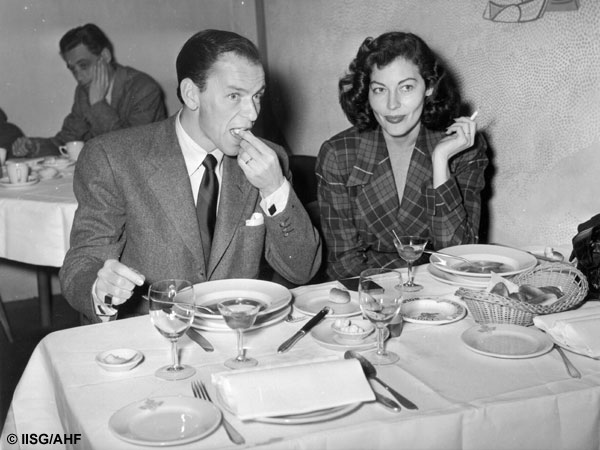
Frank Sinatra and Ava Gardner (1952)
WEBSITE: To
go to my web site, in which I will update food
&
travel information and help link readers to other first-rate travel
& food sites, click on: home page
ARCHIVE: Readers may now access
an
Archive of all past newsletters--each annotated--dating back to July,
2003, by simply clicking on www.johnmariani.com/archive
SUBSCRIBE AND
UN-SUBSCRIBE: You may subscribe anyone you wish
to this newsletter--free of charge--by
clicking here.
In
This Issue
NEW YORK CORNER: BRASSERIE by John Mariani
NOTES FROM THE WINE CELLAR: Rosé Wines Get Bigger and Some Get Better by John Mariani
QUICK BYTES
WAY OUT WEST IN TEXAS
by John Mariani
The Gage Hotel
101 Highway 90 West
Marathon, Texas
www.gagehotel.com
 It takes a while to get anywhere in Texas,
so that the idea of driving from any point in the state to Marathon is
not much more daunting than driving from Houston to Dallas. Well,
it is a hike, and there's
little in Marathon to hold your interest for more than the two minutes
it takes to drive through the town. But 39 miles away there is
the great Big Bend National Park, which, aside
from a lack of deep, serpentine gorges, has as much beauty about it as
the Grand
Canyon and a lot more to see than in Monument Valley.
It takes a while to get anywhere in Texas,
so that the idea of driving from any point in the state to Marathon is
not much more daunting than driving from Houston to Dallas. Well,
it is a hike, and there's
little in Marathon to hold your interest for more than the two minutes
it takes to drive through the town. But 39 miles away there is
the great Big Bend National Park, which, aside
from a lack of deep, serpentine gorges, has as much beauty about it as
the Grand
Canyon and a lot more to see than in Monument Valley.
Big Bend almost sneaks up on you as you drive
to it along Route 385 from the north, for all of a sudden the flat
Chihuahuan Desert scrubland turns into sloping hillsides and then
craggy mountains riven with valleys and rivers, including the Rio
Grande and Rio Bravo, which the park borders for one-quarter of the
length of the Texas-Mexico border. It is a trekker's paradise,
and there are five recommended driving tours, including two through the
beautiful Chisos Mountain Basin. If you go in spring the
territory is ablaze with 1,200 species of plants, including Texas'
state flower, the bluebonnet.
So after a long day of hiking or four-wheel
driving, you could head to Terlingua or Lajitas for food or lodgings,
but if
you go Marathon you'll find a unique place to stay and one of the best
new restaurants in Texas.  This is The
Gage Hotel,
which was opened in 1927 by
rancher-banker Alfred Gage, mainly as a trail stop and hangout
for his
friends and
ranchers in the area. Marathon did not exactly
grow bigger or richer during the Depression years, and the
property had fallen
into decrepitude when, several years ago, rancher and art
collector J.P.
and Mary Jon Bryan of Houston arrived to inquire about selling the
place. As the story goes, J.P. made an offer on the place but
waved his wife off from going inside because it was in such terrible
shape.
This is The
Gage Hotel,
which was opened in 1927 by
rancher-banker Alfred Gage, mainly as a trail stop and hangout
for his
friends and
ranchers in the area. Marathon did not exactly
grow bigger or richer during the Depression years, and the
property had fallen
into decrepitude when, several years ago, rancher and art
collector J.P.
and Mary Jon Bryan of Houston arrived to inquire about selling the
place. As the story goes, J.P. made an offer on the place but
waved his wife off from going inside because it was in such terrible
shape.
Restoration began in earnest, with
the addition of a charming courtyard and series of Los Portales
rooms, which resemble the kind of structures U.S. Cavalry troops once
stayed in (below). In
2003 and the Desert
Moon
Spa was added, admirably without compromising the historic sense of the
property. Now, in every room are paintings, tapestries, ceramics,
and rugs from the Bryans' extraordinary collection of western art, so
that when you turn one way or another in your room your eye settles on
a very beautiful painted plate or a work of tooled leather.
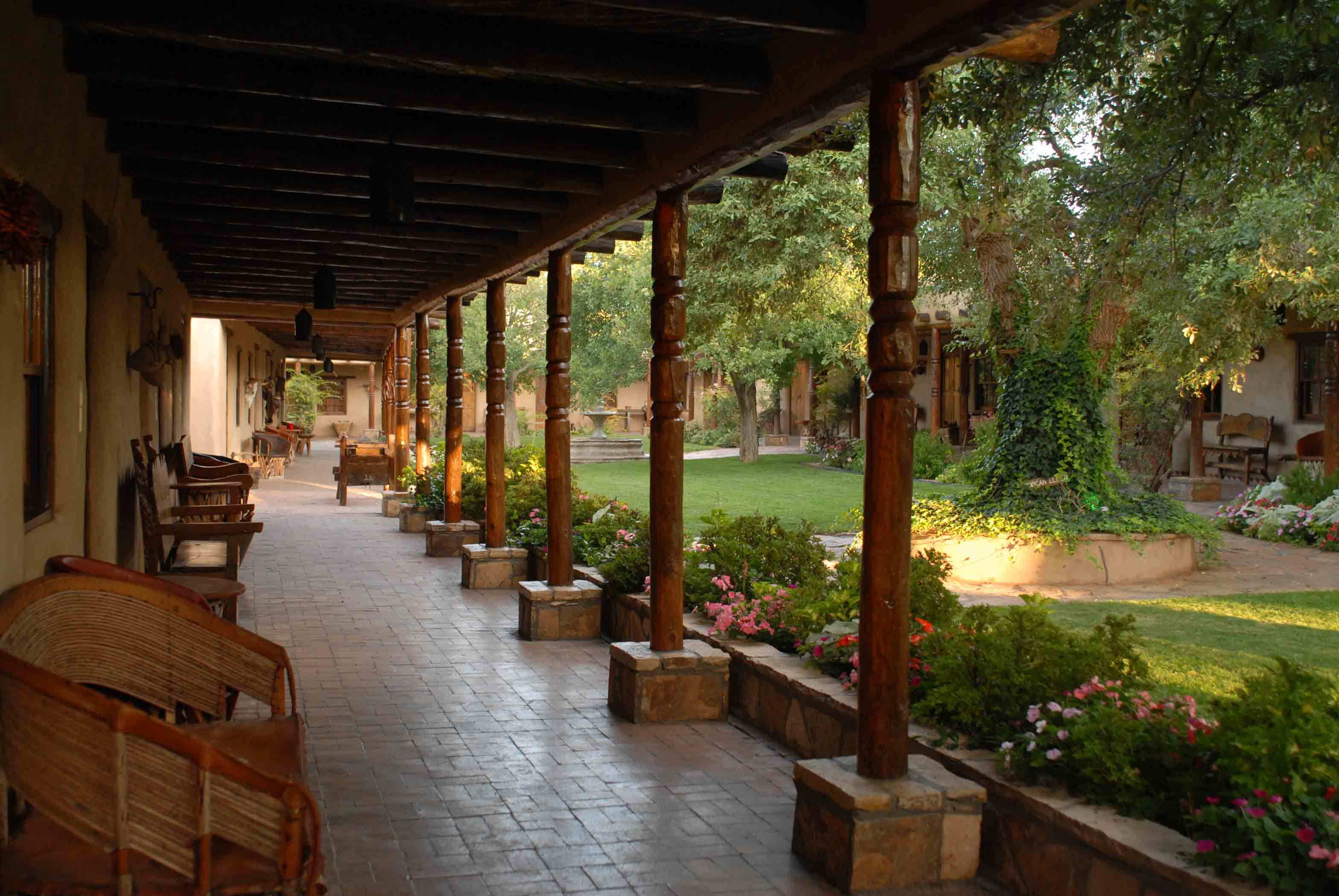 Inside
the two-story main building (above)
everything looks pretty much
the way you'd hope it would, mindful that modern amenities come in
pretty handy when dealing with an historic property like this. There
are some rooms with a bath down the hall (men's and women's), which
carries a certain nostalgic cachet, I suppose, but most rooms in the
main
house, as well as in flanking casitas along the garden, have their own
baths and showers.
Inside
the two-story main building (above)
everything looks pretty much
the way you'd hope it would, mindful that modern amenities come in
pretty handy when dealing with an historic property like this. There
are some rooms with a bath down the hall (men's and women's), which
carries a certain nostalgic cachet, I suppose, but most rooms in the
main
house, as well as in flanking casitas along the garden, have their own
baths and showers.
The Café
Cenzo restaurant has its outdoor
courtyard too, as lovely as any out of a John Ford wedding scene, and
then there is the White Buffalo Bar (below),
which takes its name from
an extremely rare, huge white buffalo head hung there, where the
clientele
seems equally divided between urban affluents arriving in Mercedes SUVs
and
local cowboys arriving in Ford pick-ups. The
night I was there one cowboy got so drunk he left
behind a stuffed
deer’s head. (They should definitely ban smoking in the bar, because
that white buffalo's fur is turning yellow.)
I suspect
you'll be hearing a lot about Chef Paul Petersen (below), 36, who brings the
full force
of his classic culinary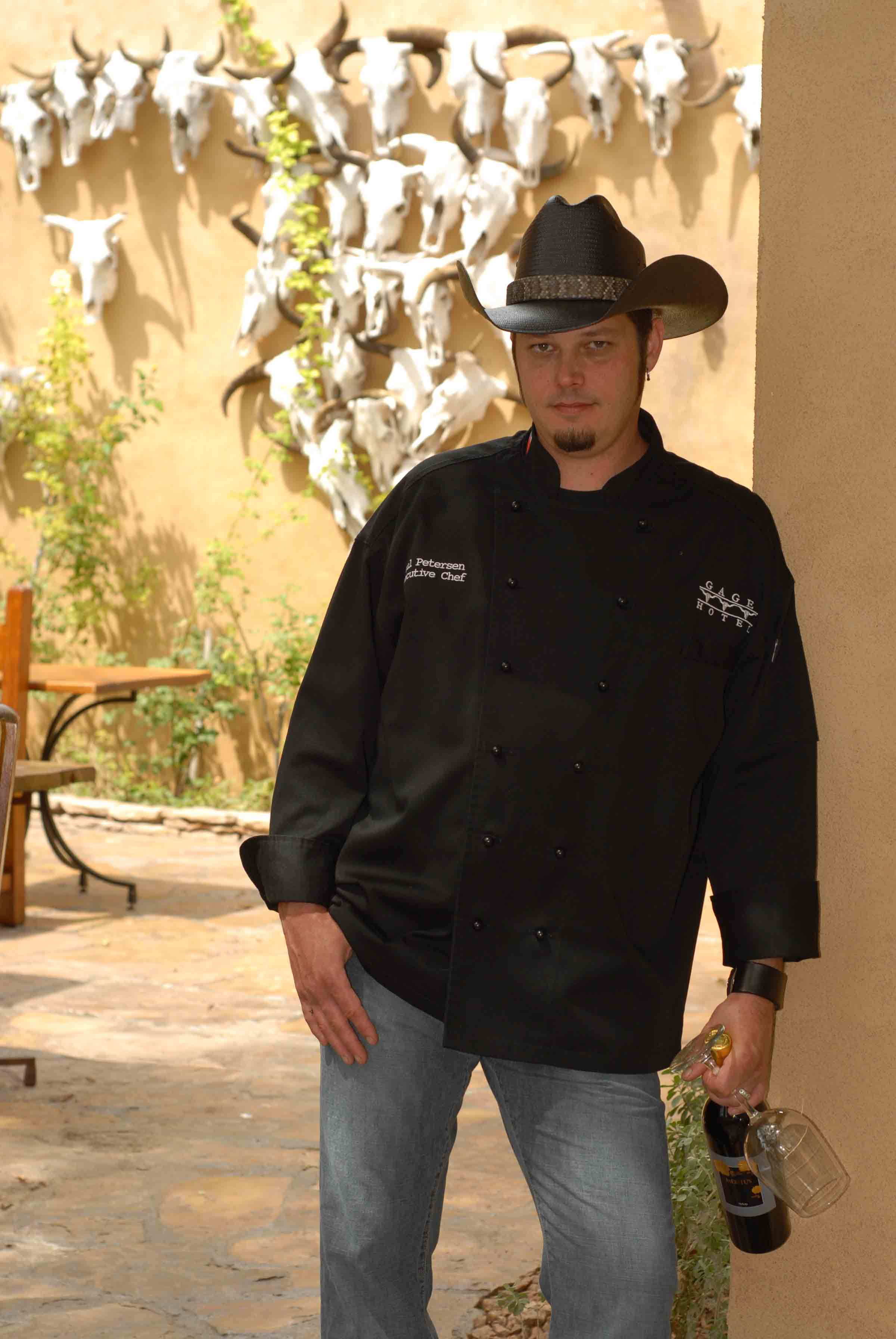 training to dishes that reflect the Texas
territory
around him
without ever forcing the issue into clichés.
Even at lunch his buffalo burger and chicken fried venison sandwich not
only get the appetite in full gear but are immensely satisfying
examples of great American lunch counter fare made as superbly as
everything else on his menu.
training to dishes that reflect the Texas
territory
around him
without ever forcing the issue into clichés.
Even at lunch his buffalo burger and chicken fried venison sandwich not
only get the appetite in full gear but are immensely satisfying
examples of great American lunch counter fare made as superbly as
everything else on his menu.
At sundown tuck into a very French torchon
of creamy foie gras with honey-stewed
apricots,
balsamic onions and grilled bread. His pan-fried veal sweetbreads
show his skill for achieveing that difficult balance of crispness and
tenderness,
softness and subtlety, all enhanced with
 Prosciutto-crusted Morbier cheese is a nice idea, and his
ancho-glazed quail has a nice bite,
served with a lovely roasted
pear salad with
smoked red onion vinaigrette and a fried quail egg. which went very
well with a bottle of Fall Creek Meritua 2003, a wine from Texas.
Prosciutto-crusted Morbier cheese is a nice idea, and his
ancho-glazed quail has a nice bite,
served with a lovely roasted
pear salad with
smoked red onion vinaigrette and a fried quail egg. which went very
well with a bottle of Fall Creek Meritua 2003, a wine from Texas.
NEW YORK CORNER
by John Mariani
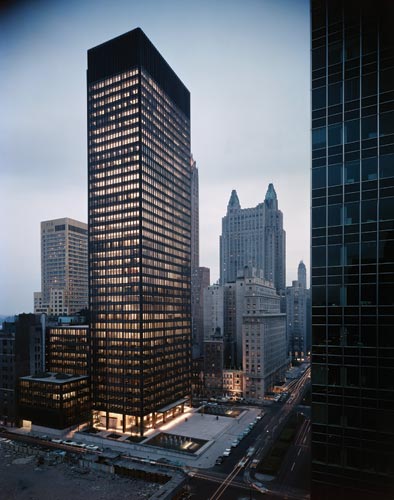 BRASSERIE
BRASSERIE100 East 53rd Street
212-751-4840
www.rapatina/com/brasserie
Putting a restaurant into the Seagram Building was an idea proposed by Restaurant Associates--RA--and, since Mies van der Rohe had no interest in such a project, his protégé Philip Johnson was hired to work with RA's own designer, Bill Pahlmann, to create a restaurants like no other before or since. The Four Seasons was the crown jewel of RA's many restaurants, most of them themed, like the Forum of the Twelve Caesars and Fonda del Sol. On the north end of the building RA put in a more casual restaurant called the Brasserie, whose principal virtue was to be open 24/7. Still, the food was to be of a high order in an American brasserie fashion, and its jet age, subterranean design was strikingly different from both the Four Seasons or any other restaurant anywhere. A 1971 review by Forbes Magazine said the Brasserie had "cold-cool decor and the coolest, coldest crowd in town" (whatever that means) and that "It's probably New York's most sophisticated unrich restaurant."

The Brasserie has always been more proletarian than its upscale neighbors, The Four Seasons and, more recently, the Lever House Restaurant, but its current chef, Franklin Becker, has brought a luster to the food that I think is as good or better than those high-priced power lunch spots.
Becker has an amazing ability to deliver on what is all too often merely a cliché in others' hands--straightforward but wholly imaginative American food based on the finest ingredients available. You've heard that claim a million times before, I know, but at the Brasserie it is the real deal, a perfect amalgam of ingredients and cooking processes that result in dishes that are absolutely delicious and amply American in idea and proportion.
The dining room itself, which seats 130, was redone two years ago by Ricardo Scofido & Elizabeth Driller, and still has a space age luminosity about it, though, except for its sloping gangway, it bears no resemblance to the original design. There is a backlighted wall of wine bottles, good tablecloths, and wineglasses. The lighting is both soft and revealing, with the food showing off all their color and form, and the wonderful side booths, with subtle variations of color, are like shimmering alcoves of light and intimacy while not seeming in any way shut off from the whole. It's a very happy place to be, and quite the same at breakfast, lunch, and dinner.
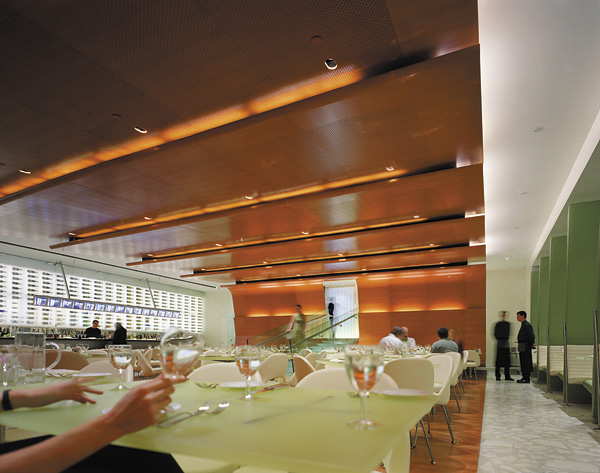
The short menu with big type and a cover that seems to be a kind of hologram is very user friendly, with 11 appetizers, plus raw bar options, six seafood items, two "chicken & eggs," two meat, and five steaks, which, admirably, come with French fries and sauces you'd otherwise spend another ten bucks for in any NYC steakhouse. We started off with finely textured grilled octopus simply dressed with lemon and spiked with hot pepper oil. A terrine of foie gras--always a Becker specialty--comes with strawberry and rhubarb compote, and a salad of asparagus with spring onions and sunflower sprouts is served warm, which gives a small twist to the idea. So, too, when I moaned to see yet another tuna tartare and beet salad on yet another menu, Becker promised his were different, and they were, just enough to make me smile that there is always something wonderful about a cliché rethought and revived: The tuna tartare was flattened into a thin sheet, served with avocado, cucumber, and relish, and the red and gold baby beets were sliced and lapped over each other, with Humboldt Fog goat's cheese. Not earthshaking, just delicious. Had a French chef done the same items, he might have sprinkled crushed truffles on them and charged three times more.
So, too, grilled Mediterranean sea bass needed nothing more than lemon, parsley, and olive oil to bring out all the fish's own flavor. The only off-note of the evening were some pan-roasted sea scallops with artichokes because the scallops were watery and flavorless.
Pan-roasted "Giannone Chicken" with asparagus, wild mushrooms and a fine old-fashioned Madeira sauce, did deserve having its producer being named, for this is a signature bird, fleshy and full of flavor all on its own, so that the sauce merely anointed its excellence. Best of all--and perhaps the very finest lamb I've ever had--were pan-roasted Colorado chops, big and meaty, with a perfect rind of fat and a chewiness that revealed more and more flavor with every bite. Accompanied by peas and carrots and new potatoes, it was testament to American food and Colorado lamb. We also tried some terrific side dishes, including great French fries and nicely herbaceous spaetzle.
All of which made us anticipate desserts that proved of equal standing, including a trio of chocolates (luscious pot de creme, deep dark sorbet, and creamy tarte) and a trio of raspberries (vanilla raspberry coupe, sorbet, and crisp rice pudding), and a candied ginger soufflé glacé with rhubarb-orange compote and honey crisp.
A meal at the Brasserie speaks volumes about how far American cuisine in a master chef's hands has become. I cannot imagine the most fastidious French or Italian or Japanese chef not delighting in the good, honest flavors of such food.
Brasserie is open for breakfast and lunch
NOTES FROM THE WINE CELLAR
by John Mariani
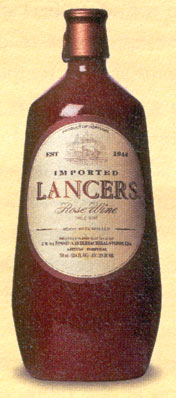
Like me, most winelovers grow up to relegate rosé wines to some unvisited limbo between whites and reds. Rosés are pale but pretty wines appropriately drunk at a seaside bistro in
Rosés are made by crushing red grapes and allowing the skins to be in short contact—8 to 48 hours--with the juice to obtain a pink or salmon-like color. The best known French rosés are usually made from grenache in Tavel and Lirac in the Southern Rhone Valley, while in
In Spain rosés are called rosados, in Italy rosatos, in South Africa Blanc de Noir , and in California, more often than not, blush wines, including the once faddish white zinfandel.
I’m told that there has been a slow rise in interest in rosé wines at
I assembled a slew of rosés along with a BLT sandwich to taste them with. The salty, smoky bacon, the sweetness and tang of the tomato, and the crisp lettuce seemed to bring out the best in the wines. I might also have elected to make a salade niçoise, perhaps some grilled mackerel or bluefish with a squirt of lemon.
My overall reaction was that the deeper the rosé hue the richer the flavor, and the older the rosé the more it has to lose. Thus, just as an experiment, I tasted a Spanish Viña Tondonia Crianza 1995 ($25) whose salmon color was tinged with a telltale brown: the wine had oxidized a long time ago and was undrinkable.
 The rest were all from 2005 or 2006. The
palest of these—just barely pink—was a Robert
Sinskey Vineyards Vin
Gris of
Pinot Noir 2006 ($20) from California’s Napa Valley. Despite a lack of much color it had a nice
acidic bite on the palate and a hint of sweet fruit beneath, finishing
well if
not brilliantly. Despite its French name, Copain Le Printemps Rosé 2005
($18)
comes from Mendocino County. It had a deep rosy hue and plenty of
fruit, though
barely any bouquet at all and faded fast. Its principal virtue seemed
to me
that it was refreshing.
The rest were all from 2005 or 2006. The
palest of these—just barely pink—was a Robert
Sinskey Vineyards Vin
Gris of
Pinot Noir 2006 ($20) from California’s Napa Valley. Despite a lack of much color it had a nice
acidic bite on the palate and a hint of sweet fruit beneath, finishing
well if
not brilliantly. Despite its French name, Copain Le Printemps Rosé 2005
($18)
comes from Mendocino County. It had a deep rosy hue and plenty of
fruit, though
barely any bouquet at all and faded fast. Its principal virtue seemed
to me
that it was refreshing.Two French examples proved very different but very dull. Château de Passavant 2006 ($18) from the Loire Valley had a very odd, distastefully herby flavor, not unlike dry anisette, which might be all right with a Marseilles bouillabaisse or fennel tart with sardines, but not much else. Mas du Fadan Côtes du Ventoux 2006 ($12) showed true to form as a Rhone made no dents in my palate at all with any degree of pleasure.
The two deepest-colored wines I tried were easily the best and most delightful: Crios de Susana Balbo Rosé of Malbec 2006 from Argentina was not only well priced at $12 but a really lovely wine, quite rich in bouquet and body, ruby red with raspberry flavors, and a long finish. Best of all was a wine I might characterize as a light red rather than a rose—Antichi Vigneti di Cantalupo Il Mimo Colline Novaresi Nebbiolo 2006 ($15), with a big cherry aroma and flavor, a mouth-filling wine that is a lot better than most white Croatina wines from the same territory of Ghemme.
These last two rosés I would drink with pleasure as an aperitif or with light summer foods, charcuterie, cheeses, and especially oil fishes like salmon, mackerel, mullet, and bluefish. The rest I wouldn’t much care to drink again.
I did, for a moment, think of trying some Mateus or Lancer’s just for fun, but by then I’d run out of BLT.
THE REAL REASON TONY BLAIR RESIGNED!
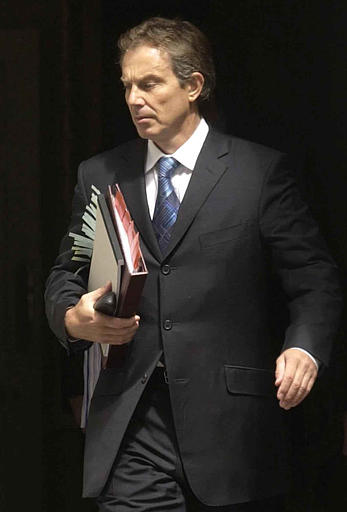
"If Tony Blair found time this week to read a survey published in The Grocer magazine, he must have been devastated. . . . After all, no one goes into public life expecting one day to find that only 2 percent of senior people in the dairy industry thinks the Government is supportive enough of the cheese industry. And which of us could truly sleep at night once we discovered that 52 percent consider this Government to be actively 'anti-cheese'?"--Natalie Haynes, "Anti Cheese? Excuse me while I process that," The Times (May 5, 2007).
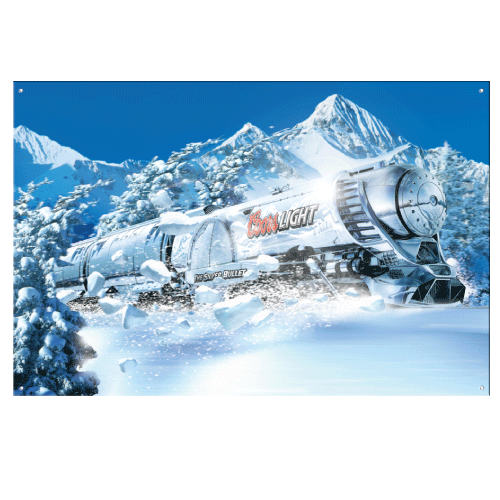
PAR-TEE!!! PAR-TEE!!
A tanker train carrying Coors beer crashed into a parked locomotive and spilled beer into downtown Denver.
QUICK BYTES
* Now through Labor Day at Wright’s at The Arizona Biltmore, the “Dinner & A Movie” offers and evening of American Lodge Cuisine and children 12 and younger eat free, while watching popular movies on the Biltmore’s “big screen.” Saturday at the resort is “Dive-In Movie” night at the Paradise Pool. A Cabana Special will be offered on Saturday nights this
Everett Potter's Travel Report:
Tennis Resorts Online: A Critical Guide to the World's Best Tennis Resorts and Tennis Camps, published by ROGER COX, who has spent more than two decades writing about tennis travel, including a 17-year stretch for Tennis magazine. He has also written for Arthur Frommer's Budget Travel, New York Magazine, Travel & Leisure, Esquire, Money, USTA Magazine, Men's Journal, and The Robb Report. He has authored two books-The World's Best Tennis Vacations (Stephen Greene Press/Viking Penguin, 1990) and The Best Places to Stay in the Rockies (Houghton Mifflin, 1992 & 1994), and the Melbourne (Australia) chapter to the Wall Street Journal Business Guide to Cities of the Pacific Rim (Fodor's Travel Guides, 1991). Click on the logo below to go to the site.
~~~~~~~~~~~~~~~~~~~~~~~~~~~~~~~~~~~~~~~~~~~~~~~~~~~~~~~~~~~~~~~~~~~~~~~~~
MARIANI'S VIRTUAL GOURMET NEWSLETTER is published weekly. Editor/Publisher:
John Mariani. Contributing Writers: Robert Mariani, Naomi
Kooker, Kirsten Skogerson, Edward Brivio, Mort
Hochstein, Suzanne Wright. Contributing
Photographers: Galina Stepanoff-Dargery, Bobby Pirillo. Technical
Advisor: Gerry McLoughlin.
Any of John Mariani's books below
may be ordered from amazon.com by clicking on the cover image.
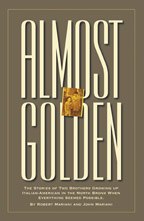 My
newest book, written with my brother Robert Mariani, is a memoir of our
years growing up in the My
newest book, written with my brother Robert Mariani, is a memoir of our
years growing up in the For those of you who don't think of the Robert and I think you'll enjoy this very personal look at our --John Mariani |
 |
 |
 |
 |
 |
 |
copyright John Mariani 2007

